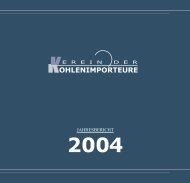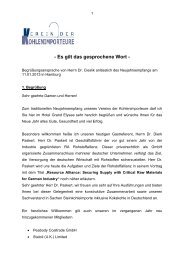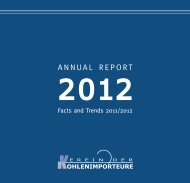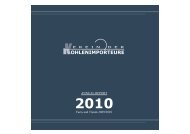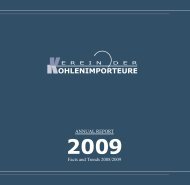Annual Report 2010 - Verein der Kohlenimporteure eV
Annual Report 2010 - Verein der Kohlenimporteure eV
Annual Report 2010 - Verein der Kohlenimporteure eV
You also want an ePaper? Increase the reach of your titles
YUMPU automatically turns print PDFs into web optimized ePapers that Google loves.
62 Steam Coal Market Enjoys Positive Outlook<br />
in 2011<br />
Demand<br />
Demand for electricity on the Asian market continues to<br />
grow rapidly, with high growth rates in many countries.<br />
Even so, large parts of the population in Asia, Africa<br />
and South America still have no access to electricity,<br />
so we can count on dynamic growth in the long term.<br />
<br />
<br />
the first time more people in the world live in towns<br />
than in the country. According to UN forecasts, urban<br />
<br />
In Europe, imported coal is replacing the decline in<br />
indigenous production. On the other hand, it must<br />
increasingly compete with natural gas that has become<br />
less cheaper. Since indigenous production in Germany,<br />
Poland and Spain will continue to decline, import<br />
volumes will probably be maintained in the long<br />
term, but perhaps not increase substantially given the<br />
additional burden of the cost of CO 2 certificates and the<br />
further development of renewable energies, especially<br />
if the EU Emissions Trading Scheme remains a globally<br />
isolated solution.<br />
According to the International Energy Agency’s (IEA)<br />
“New Policies Scenario”, world demand for electricity<br />
will increase on average by more than 2% each year<br />
<br />
30,300 TWh in 2035.<br />
According to IEA estimates, more than 80% of the<br />
increase in global electricity demand comes from<br />
developing and emerging countries, while in OECD<br />
countries, the increase is slower because of mandated<br />
efficiency improvement. ExxonMobil in its “Outlook<br />
for Energy: A View to 2030” comes to similar results:<br />
demand for electricity will increase from the present<br />
20,000 TWh by 80% globally by 2030. While for<br />
OECD countries, only a 25% increase is forecast<br />
compared with <strong>2010</strong>, the increase in electricity demand<br />
in non-OECD countries is 150%, of which China alone<br />
accounts for 35%.<br />
The share of global power generation from coal will<br />
probably decrease by 2035 according to IEA data,<br />
possibly by 25%. The reason for this is the volume of<br />
relatively inexpensive, unconventional gas available on<br />
the market that could partially displace coal and also<br />
the stronger emergence of renewable energy sources.<br />
Supply<br />
Pacific suppliers – above all Indonesia – continue<br />
to increase their supply. The programme for the<br />
expansion of ports and railways in Australia reaped<br />
its first rewards in 2011. However, the heavy rainfalls<br />
and subsequent flooding that lasted for weeks nearly<br />
brought production in Queensland to a halt and badly<br />
damaged some infrastructure. China is continuing to<br />
reduce its exports because of high domestic demand,<br />
but nevertheless remains an exporter to a certain extent.<br />
It is difficult to evaluate Vietnam’s potential. Exports<br />
to date have been handled flexibly. The Vietnamese<br />
government was concerned about high exports and<br />
so cut them back. It will however ease its restraint on<br />
exports if domestic demand becomes weaker. Russia is<br />
increasing its Pacific exports and expanding shipping<br />
<br />
In the Atlantic region, Colombia and Russia in<br />
particular have the potential to develop their exports.<br />
South Africa is currently stagnating. Poland’s<br />
contribution to seaborne exports is stabilising at a<br />
low level. Indonesia might lose market shares on the<br />
Atlantic market in favour of Asian customers. Smaller<br />
steam coal producers – Venezuela and Spitzbergen in<br />
Norway – complete the available sources of traded coal.<br />
High market prices are now improving the competitive<br />
position of the USA as a “swing supplier”. The USA



